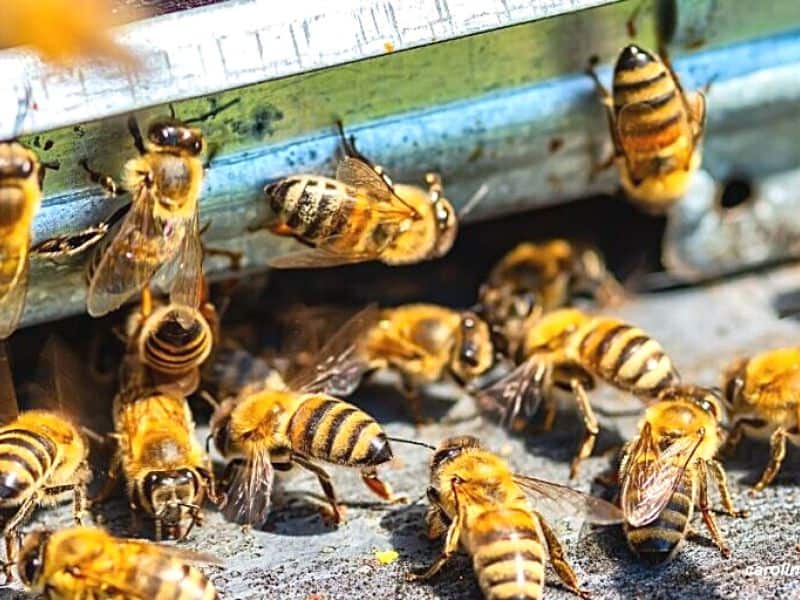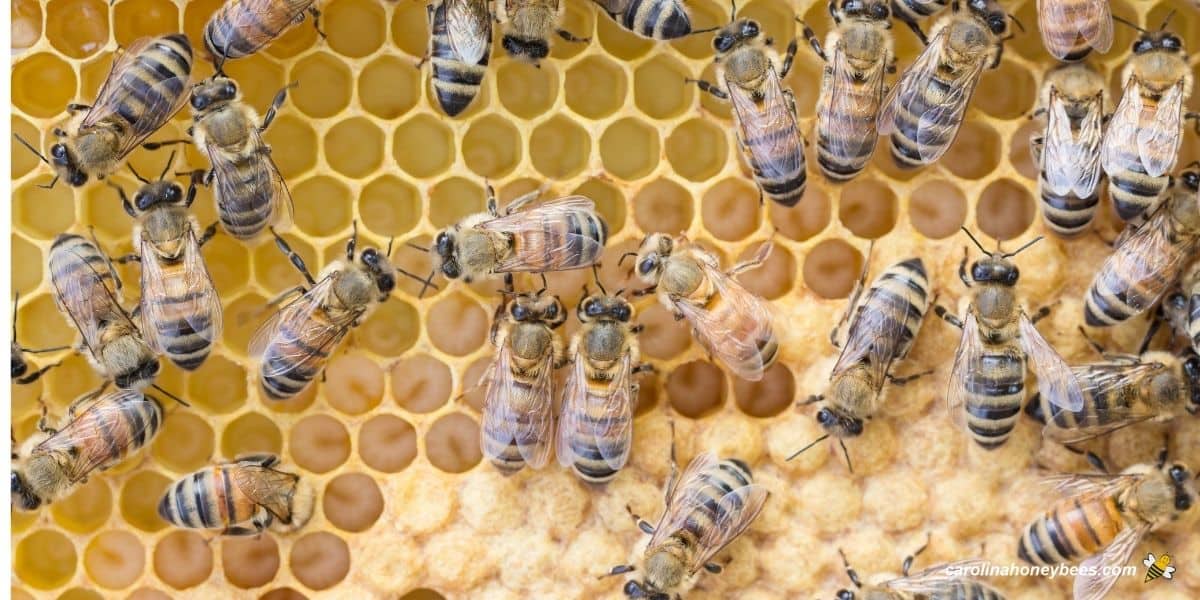Honey Bee Pheromones
Honey bees are remarkable insects that rely heavily on chemical signals for communication. Members of the colony produce various honey bee pheromones to direct daily activities. This is essential, otherwise – how would a family with thousands of individual members get anything done? In this article, I share the most common pheromones found in the beehive and how they affect the colony.

Beekeepers are blessed to get a close look at bee life. We see first hand miraculous facts about bees as they are taking place. But, bee pheromones can not be seen visually – we can only see the results.
The Role of Pheromones in Honey Bee Communication
Pheromones are chemical substances that cause certain behaviors or responses in members of the same species.
Individual bees produce pheromones much like we humans produce sweat. But, instead of a liquid to cool the body, their pheromones serve to relay information about colony status.
These chemical signals regulate everything everything from social behavior and hive defense to foraging activities.

Types of Bee Pheromones
Within the confines of colony life, we know of several different types of bee pheromones and the behaviors they control.
Each type of bee in the hive affects daily life with some type of pheromonal signals. When all of these are multiplied together – it can be a huge mass of communication.
Queen Pheromones
Much research has been done on the queen honey bee. We know a lot about her and her importance to the colony. As the only bee capable of laying fertilized bee eggs, colony survival depends on her.
Naturally, her pheromones help identify her as “the queen” or they are her royal signature.
The queen bee’s pheromones inhibit the development of worker ovaries. This suppresses a situation known as laying workers – which can disturb the balance of the hive.
With a good laying queen on the job and plenty of fresh brood, they have no reason to build new queen cells. This is a signal to the colony that all is well and daily life inside the hive continues.
Queen Substance
One of the most important bee pheromone components in the colony is spread by contact – “queen substance”. It is a combination of at least 3 substances synthesized in the mandibular glands (located in mouth) of the queen.
- 9-oxo-2-decenoci acid (9-ODA)
- 9-hydroxy-2-decenoic acid (9-HDA)
- 10-hydroxy-2-decenoic acid (10-HDA)
HDA & ODA stimulate brood rearing. Their presence tells the workers that they should prepare for raising more young. The queen will only lay eggs in cells that have been cleaned and polished by workers.
Queen substance pheromones also help maintain the “queen retinue”. This refers to the small group of workers that you often see surround the queen. They care for the queen – feeding and grooming her.
What happens in a hive with a lack of queen bee pheromones. Colony bees will kill a failing queen and attempt to replace her when her pheromone levels drop low.

Worker Pheromones
Most of the members of a colony are female worker bees. These bees collect resources needed by the colony, perform numerous tasks inside the hive and serve as guard bees for defense.
The chemical signals produced by workers help direct daily tasks that are needed to sustain the hive. Three common worker bee pheromones are:
- scenting (calling substance)
- stinger alarm pheromone
- footprint pheromone
Scenting
Any beekeeper can observe the behavioral results of pheromones from the nasonov gland. This is the scenting gland (used when bees are fanning) located near the tip of the worker’s abdomen. These gland secretions produce geraniol and citral – this is a “calling substance”.
Bees can be seen doing this at the entrance of the nest, on the surface of a swarm or any time you move them to a new spot. They are calling to their sisters.
Alarm Pheromone
Another worker bee pheromone is “isopentyl acetate”. It is produced by glands near the bee sting. This is an alarm or danger signal, it calls other members of the colony to come and help defend the hive.
Honey bees are not the only insects with alarm pheromones. Yellow Jackets (like honey bees) do the same thing when stinging. This is why is it so important to move away before their sisters arrive to sting you too.

Drone Pheromones & Reproductive Behavior
Male bees (called drones) have the primary role of mating with new queens. But, drone bees also produce pheromones and react to those produced by other bees.
Drone-produced pheromones are involved in honey bee reproduction. They help attract virgin queens to drone congregation areas. This is where mating takes place – far away from the hive.

Brood Pheromones
Adult bees are not the only members of the colony that produce chemicals that control behavior. Developing bees (brood) produce them too – brood pheromones.
Brood pheromones are produced on the surface of the larval skin (cuticle). These chemical signals serve several purposes.
Bee larvae are eating machines – their only occupation is to eat and grow. Brood pheromones encourages the development of the hypopharyngeal glands in the nurse bees to produce more brood food.
An abundance of brood pheromones encourages foraging bees to collect more pollen. This protein rich food is essential for brood rearing.
In addition, brood in the colony helps to inhibit ovary development in workers (similar to queen substance).
Enemies of the colony also make use of brood pheromones. Varroa mites are able to locate brood (especially the preferred drone brood) by these chemicals messengers.

Footprint Pheromones
Footprint pheromones are chemical messenger left by bees as they walk across surfaces. This may be a flower they are visiting to collect nectar or pollen – or even the comb inside the hive.
Footprint messages help bees mark territory and make foraging and even movements within the hive more efficient.
What Pheromones Tell Beekeepers
So, what does this mean to the average backyard beekeeper? It is not so important that you remember their names or how to spell them. But, you do need to understand that there are things affecting our bees that we don’t see.
Queen pheromones are why a beekeeper can not usually requeen a hive abruptly. The new queen doesn’t “smell” right – she has to be introduced slowly after the old queen is gone.
You find your bees are building queen cells? Are they about to swarm or needing to replace a failing queen? It involves a bit of guess work.
However, if the hive and brood nest are not crowded and there are a small number of queen cells being built – perhaps your queen is failing.
Another situation you might experience that is related to bee pheromones. Are those bees at the entrance fighting or just checking returning workers?
Workers approaching the entrance may be inspected to insure they are not a robber bees. Fighting is a signal that the intruders are not recognized.
Even activities such as washboarding bees – which are mysterious in a way – likely have a chemical signal base. Aren’t bees wonderful!
FAQs
Pheromones act as a silent language, allowing bees to convey information about reproductive status, hive health, and specific tasks.
Honey bees produce various pheromones, including those emitted by queens, workers, and drones. Each type of pheromone serves specific functions in regulating hive activities.
Beekeepers who grasp the nuances of honey bee pheromones can enhance hive management, anticipate behavioral changes, and address issues such as queen succession, ultimately promoting the well-being of their colonies.
Final Thoughts
We have looked at only a few of many honey bee pheromones, yet it is easy to understand why they are so important. Their presence or absence allows workers to understand much about the condition of the colony. This is done quickly without having to tell each one of your 20,000 – 60,000 sisters.
More Resources:

